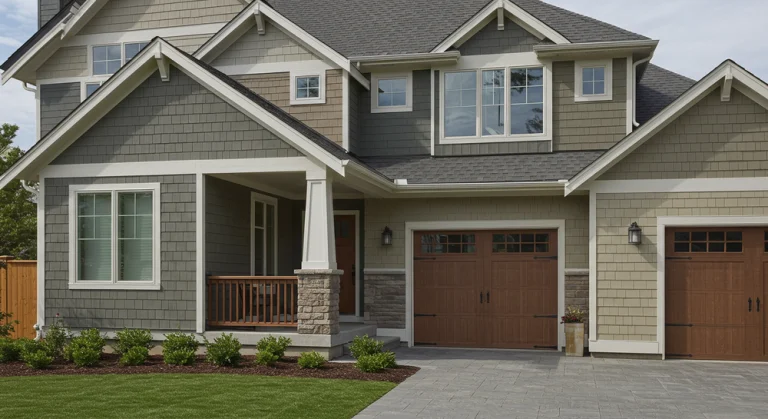Your home’s siding isn’t just about aesthetics; it plays a crucial role in protecting your house from the elements. Over time, even the best siding materials deteriorate, making it essential to recognize when it’s time for a replacement. Ignoring damaged siding can lead to costly repairs, structural damage, and even health hazards like mold growth.
So, how do you know when it’s time to replace your home siding? Here are the top warning signs every homeowner should look out for.
Why Home Siding Matters
Siding serves three essential functions:
-
Protection: It acts as a shield against harsh weather conditions like rain, snow, and strong winds.
-
Aesthetics: A well-maintained exterior boosts your home’s curb appeal and overall value.
-
Energy Efficiency: Good siding helps insulate your home, keeping energy bills in check.
Now, let’s dive into the telltale signs that indicate your siding may need a full replacement.
Signs It’s Time to Replace Your Home Siding
- Cracks and Gaps in the Siding – Cracks and gaps in siding allow moisture, pests, and drafts to penetrate your home. If you notice these issues, especially after a storm or harsh weather, it’s a sign that your siding is weakening. Small cracks might seem harmless, but they can expand quickly, leading to severe damage.
- Warping and Bubbling – Warping or bubbling is a clear indicator of moisture problems beneath your siding. If parts of your siding appear misshapen or puffed out, it means water has infiltrated the material, compromising its structural integrity. Ignoring this can lead to hidden mold growth and serious internal damage.
- Rotting or Soft Spots – If your siding feels soft or crumbles under light pressure, it’s rotting. This is especially common with wood siding when moisture seeps in. Rot spreads fast, making replacement urgent to prevent further structural issues.
- Mold, Mildew, and Fungus Growth – Mold, mildew, or fungus growing on your siding—especially near the seams—indicates excess moisture. While some surface mold can be cleaned, persistent growth is a sign of deeper water infiltration, requiring immediate attention.
- Increased Energy Bills – Has your heating or cooling bill skyrocketed? Damaged siding compromises your home’s insulation, making it harder to regulate indoor temperatures. If you’ve sealed doors and windows but still notice drafts, your siding could be the culprit.
- Fading and Peeling Paint – Siding should hold its color for years, but excessive fading signals material deterioration. If your siding requires frequent repainting or the color looks dull and patchy, it might be time for a full replacement.
- Interior Wall Damage – Have you noticed peeling wallpaper, bubbling paint, or water stains inside your home? These could be signs that moisture is seeping through failing siding. Interior damage often indicates bigger underlying problems outside.
- Pest Infestation – Termites, carpenter ants, and other pests love burrowing into weak siding. If you notice holes, tunnels, or insect activity, your siding may already be compromised, necessitating an immediate replacement.
- Outdated or Unsightly Appearance – If your siding looks outdated, worn, or simply doesn’t match your home’s style anymore, it might be time for an upgrade. New siding enhances curb appeal, increases property value, and gives your home a fresh, modern look.
- Frequent Maintenance and Repairs – Are you constantly repairing your siding? If the cost and effort of maintenance are piling up, replacing it altogether may be a smarter long-term investment. Newer materials like vinyl and fiber cement require minimal upkeep and last longer.
Choosing the Right Siding for Your Home
When replacing siding, consider these popular options:
-
Vinyl Siding: Affordable, durable, and low-maintenance.
-
Wood Siding: Offers natural beauty but requires more upkeep.
-
Fiber Cement Siding: Highly durable, resistant to fire and pests.
-
Metal Siding: Long-lasting and weather-resistant.
How to Hire a Professional for Siding Replacement
Hiring the right contractor ensures a successful siding replacement. Here are some tips:
-
Check Reviews & References: Look for customer feedback and ask for past project references.
-
Verify Licensing & Insurance: Ensure they are properly certified and insured.
-
Request Multiple Quotes: Compare prices and services before making a decision.
-
Ask About Warranties: A good contractor should offer material and workmanship warranties.
Your home’s siding is crucial for protection, efficiency, and aesthetics. If you’ve noticed any of these warning signs, don’t wait until the damage worsens. Replacing your siding can save you money in the long run, increase your home’s value, and enhance your peace of mind.


